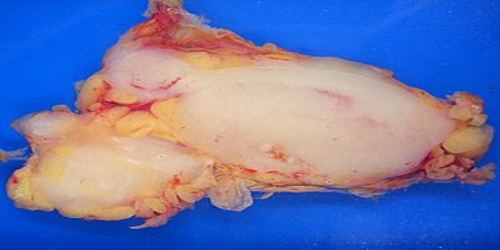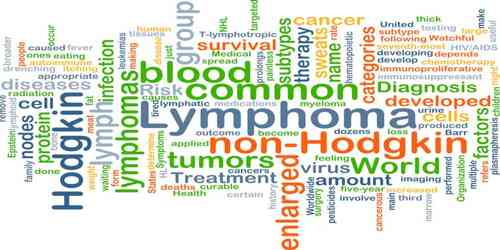About Lymphoma
Definition
Lymphoma is a cancer that starts in the white blood cells, or lymphocytes. It is a tumor of the lymphoid tissue. It occurs when lymphocytes (white blood cells that help to fight infection) become out of control. They divide in an abnormal way or do not die when they should. It can occur at any age, even in children. It is nearly always treatable; most people live for many years after being diagnosed with lymphoma. Lymphatic cancers are classified by the type of immune cells affected. The two main types are Hodgkin and non-Hodgkin. Within these, there are many subtypes.

Signs and symptoms may include enlarged lymph nodes, fever, drenching sweats, unintended weight loss, itching, and constantly feeling tired. The enlarged lymph nodes are usually painless. The sweats are most common at night. Risk factors for Hodgkin lymphoma include infection with Epstein–Barr virus and a history of the disease in the family. Risk factors for common types of non-Hodgkin lymphomas include autoimmune diseases, HIV/AIDS, infection with human T-lymphotropic virus, immunosuppressant medications, and some pesticides.
Here are some key points about lymphoma:
- Lymphoma is a cancer of the lymph nodes and lymphatic system.
- The two main types are Hodgkin and non-Hodgkin. Non-Hodgkin is the most common.
- The main symptom is usually an enlargement of lymph nodes that does not go away as it normally would after infection.
- There is no way to prevent lymphoma, but survival rates after treatment are good.
Sign, Causes and Symptoms of Lymphoma
The first sign of lymphoma is a painless swelling of lymph nodes in the neck, under an arm, or in the groin. Lymph nodes and/or tissues elsewhere in the body may also swell. The enlarged lymph node sometimes causes other symptoms by pressing against a vein or lymphatic vessel (swelling of an arm or leg), a nerve (pain, numbness, or tingling), or the stomach (early feeling of fullness).

Exactly what causes lymphoma is unclear, but there are some risk factors.
- Age: Generally, the risk of NHL increases with advancing age. HL in the elderly is associated with a poorer prognosis than that observed in younger patients. In the 20-24-year age group, the incidence of lymphoma is 2.4 cases per 100,000 while it increases to 46 cases per 100,000 among individuals 60-64 years of age.
- Infection: Certain viral and bacterial infections that transform lymphocytes increase the risk, such as the Epstein-Barr virus (EBV), which causes glandular fever in NHL. Infection with EBV can cause mononucleosis, which increases the risk of lymphoma in HL.
Lymphatic tissue is connected throughout the body, and the cancer cells can spread easily from their original location to other tissues and organs, including those outside of the lymphatic system.
Symptoms of lymphoma may vary from patient to patient and may include one or more the following:
- Fevers
- Chills
- Unexplained weight loss
- Night sweats
- Lack of energy
- Itching (up to 25% of patients develop this itch [pruritus], most commonly in the lower extremity but it can occur anywhere, be local, or spreading over the whole body)
- Loss of appetite
- Shortness of breath
- Lymphedema
- Back or bone pain
- Neuropathy
- Blood in the stool or vomit
- Blockage of urine flow
- Headaches
- Seizures
These symptoms are nonspecific, and not every patient will have all of these potential symptoms.

Treatment of Lymphoma
Treatment depends on the type of lymphoma and the stage it has reached. Indolent or slow-growing lymphoma may need only watchful waiting and no treatment.
- Biologic Therapy: This is a drug treatment that stimulates the immune system to attack the cancer cells by inserting living microorganisms into the body.
- Antibody Therapy: Synthetic antibodies are inserted into the bloodstream to combat the cancer’s antigens.
- Chemotherapy: Aggressive drug treatment is used to kills cancer cells.
- Radioimmunotherapy: This delivers high-powered radioactive doses directly into the cancerous B-cells and T-cells to destroy them.
- Radiation Therapy: This is used to focus on small areas of cancer.
- Stem-cell Transplantation: This can restore damaged bone marrow following high-dose chemotherapy or radiation therapy.
- Steroids: These may be injected to treat lymphoma.
- Surgery: This can be used to remove the spleen or other organs after the lymphoma has spread.
Surgery is used more often for obtaining a biopsy.
Reference:
















